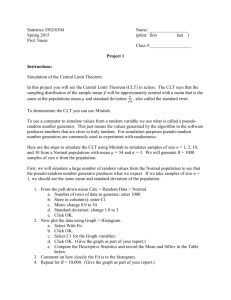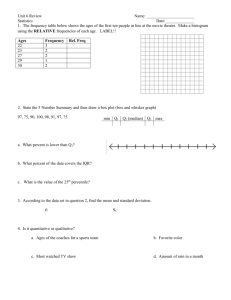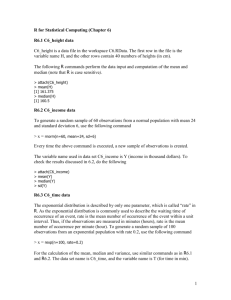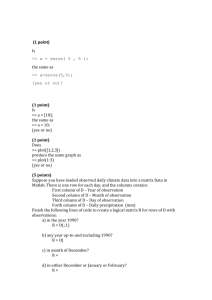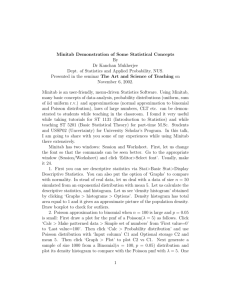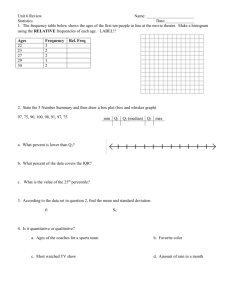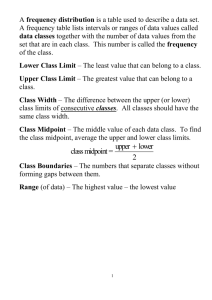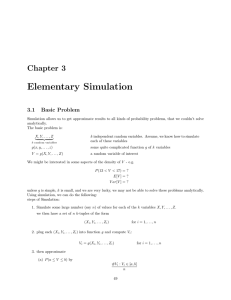Lab 3 – Binomial Distribution
advertisement
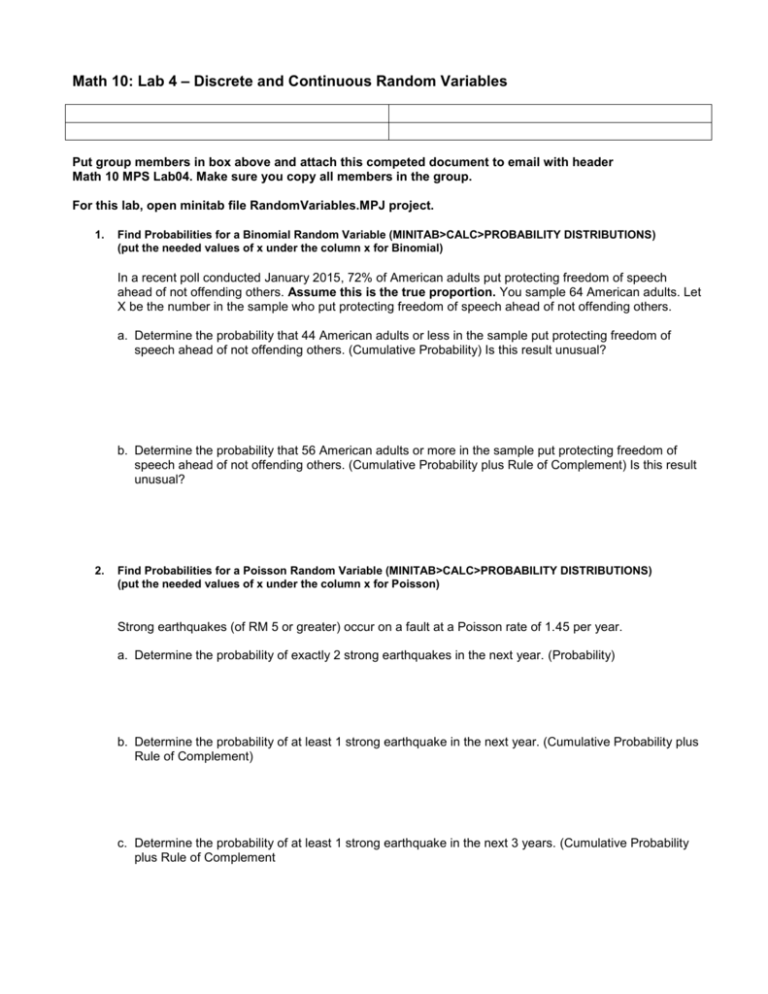
Math 10: Lab 4 – Discrete and Continuous Random Variables Put group members in box above and attach this competed document to email with header Math 10 MPS Lab04. Make sure you copy all members in the group. For this lab, open minitab file RandomVariables.MPJ project. 1. Find Probabilities for a Binomial Random Variable (MINITAB>CALC>PROBABILITY DISTRIBUTIONS) (put the needed values of x under the column x for Binomial) In a recent poll conducted January 2015, 72% of American adults put protecting freedom of speech ahead of not offending others. Assume this is the true proportion. You sample 64 American adults. Let X be the number in the sample who put protecting freedom of speech ahead of not offending others. a. Determine the probability that 44 American adults or less in the sample put protecting freedom of speech ahead of not offending others. (Cumulative Probability) Is this result unusual? b. Determine the probability that 56 American adults or more in the sample put protecting freedom of speech ahead of not offending others. (Cumulative Probability plus Rule of Complement) Is this result unusual? 2. Find Probabilities for a Poisson Random Variable (MINITAB>CALC>PROBABILITY DISTRIBUTIONS) (put the needed values of x under the column x for Poisson) Strong earthquakes (of RM 5 or greater) occur on a fault at a Poisson rate of 1.45 per year. a. Determine the probability of exactly 2 strong earthquakes in the next year. (Probability) b. Determine the probability of at least 1 strong earthquake in the next year. (Cumulative Probability plus Rule of Complement) c. Determine the probability of at least 1 strong earthquake in the next 3 years. (Cumulative Probability plus Rule of Complement Simulate a Uniform Random Variable 3. The Uniform random variable is described by two parameters, the minimum and the maximum. Each value between the minimum and the maximum has the same probability of being chosen, so the uniform random variable has a rectangular shape. In this simulation, we will model the amount of concrete in a building supply store which follows a uniform distribution from 5 to 155 tons. a. Use the column heading Uniform Sim to save data and simulate 1000 trials in Minitab (use the menu item CALC>RANDOM DATA and choose Uniform.) b. Using the command STAT>BASIC STATISTICS>GRAPHICAL SUMMARY to calculate the sample mean, sample median and sample standard deviation of the simulated data as well as a box plot and histogram and paste the output here. c. Describe the shape of the histogram. Does it appear to match the rectangular shape of the population probability graph shown above? d. Identify the minimum and maximum values. Are they near the values 5 and 155 that you used to define the model? e. The population mean and median of this random variable are both 80 tons and the population standard deviation is 43.3 tons. How do the sample statistics in the simulation compare to these population values? 4. Simulate an Exponential Random Variable The Exponential random variable is described by one parameter, the expected value or . The shape of the curve is an exponential decay model that we studied in Module 4. This random variable is often used to model the waiting time until an event occurs, where the future waiting time is independent of the past waiting time. In this simulation, we will model trauma patients arrive at a hospital’s Emergency Room at a rate of one every 5.6 minutes (5.6 minutes is the expected value.) a. Use the column heading Exponential Sim to save data and simulate 1000 trials in Minitab (use the menu item CALC>RANDOM DATA and choose Exponential. The scale box will be and the Threshold box should remain at 0.0 ) b. Using the command STAT>BASIC STATISTICS>GRAPHICAL SUMMARY to calculate the sample mean, sample median and sample standard deviation of the simulated data as well as a box plot and histogram and paste the output here. c. Describe the shape of the histogram. Does it appear to match the exponential decay shape of the population probability graph shown above? d. Identify the minimum and maximum values. Does the maximum value appear to be an extreme outlier? e. The population mean and standard deviation of this random variable are both 5.6 minutes and the population median is 3.88 minutes. How do the sample statistics in the simulation compare to these population values? 5. Simulate a Normal Random Variable The Normal random variable is described by two parameters, the expected value and the population standard deviation . The curve is bell-shaped and frequently occurs in nature. In this simulation, we will model the cooking time for popcorn which follows a Normal random variable with =4.2 minutes and =0.6 minutes. a. Use the column heading Normal Sim to save data and simulate 1000 trials (use the menu item CALC>RANDOM DATA and choose Normal.) b. Using the command STAT>BASIC STATISTICS>GRAPHICAL SUMMARY to calculate the sample mean, sample median and sample standard deviation of the simulated data as well as a box plot and histogram and paste the output here. c. Describe the shape of the histogram. Does it appear to match the bell-shape of the population probability graph shown above? d. Identify the minimum and maximum values. Determine the Z-score of each. Do these values seem to be extreme outliers? e. Compare the sample mean, median and standard deviation to the population values.
